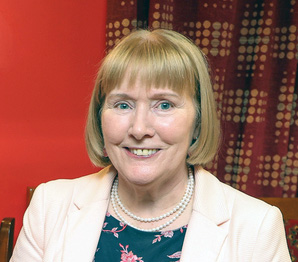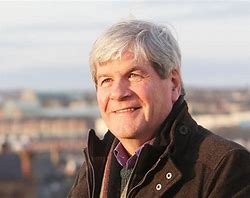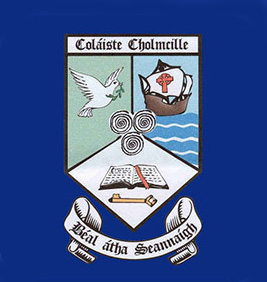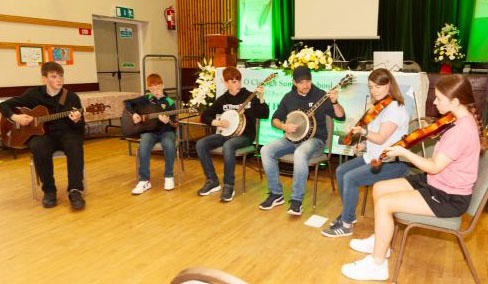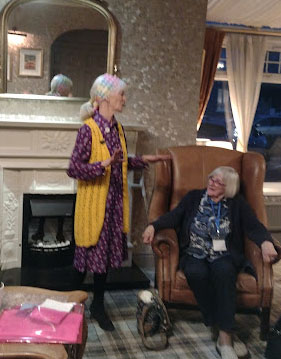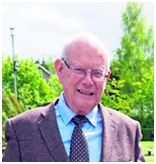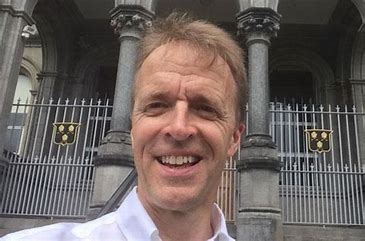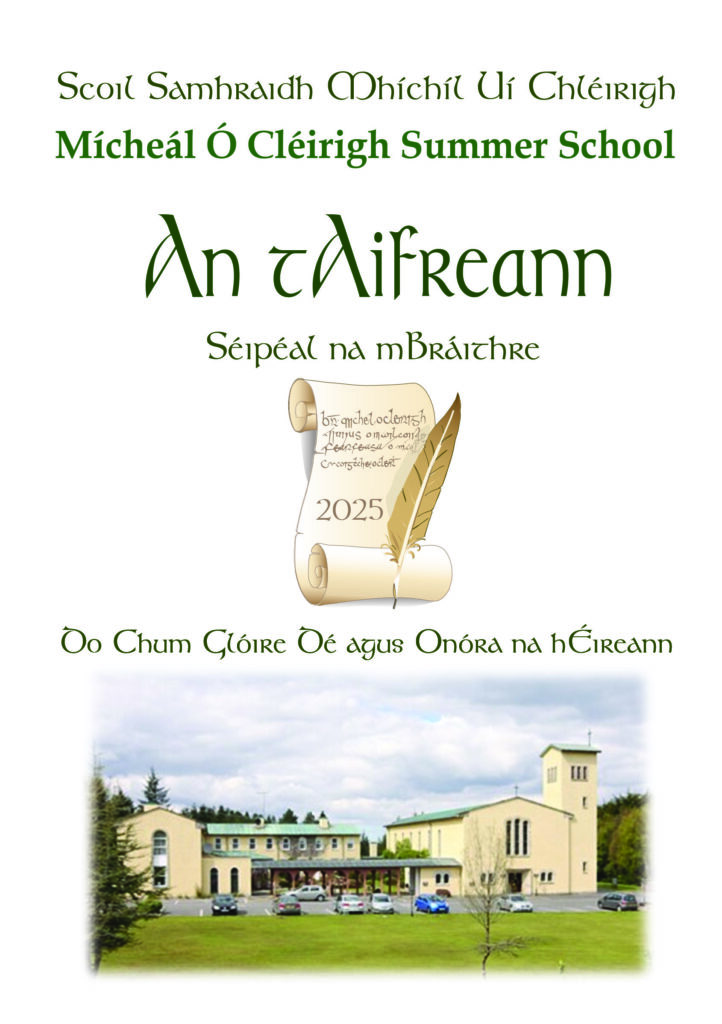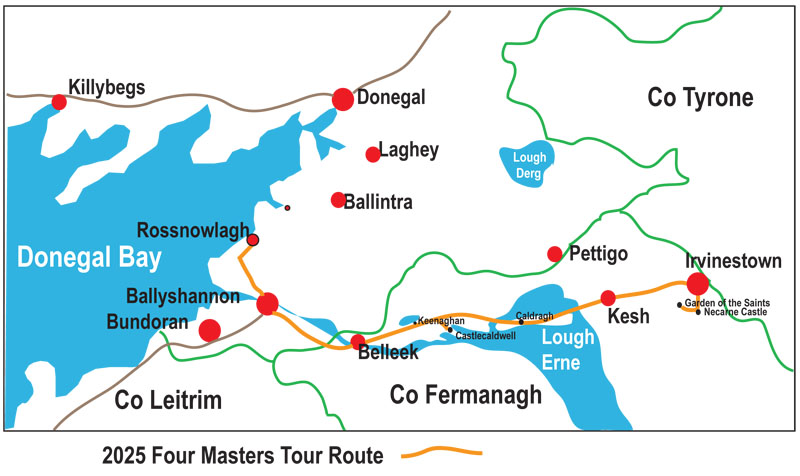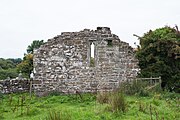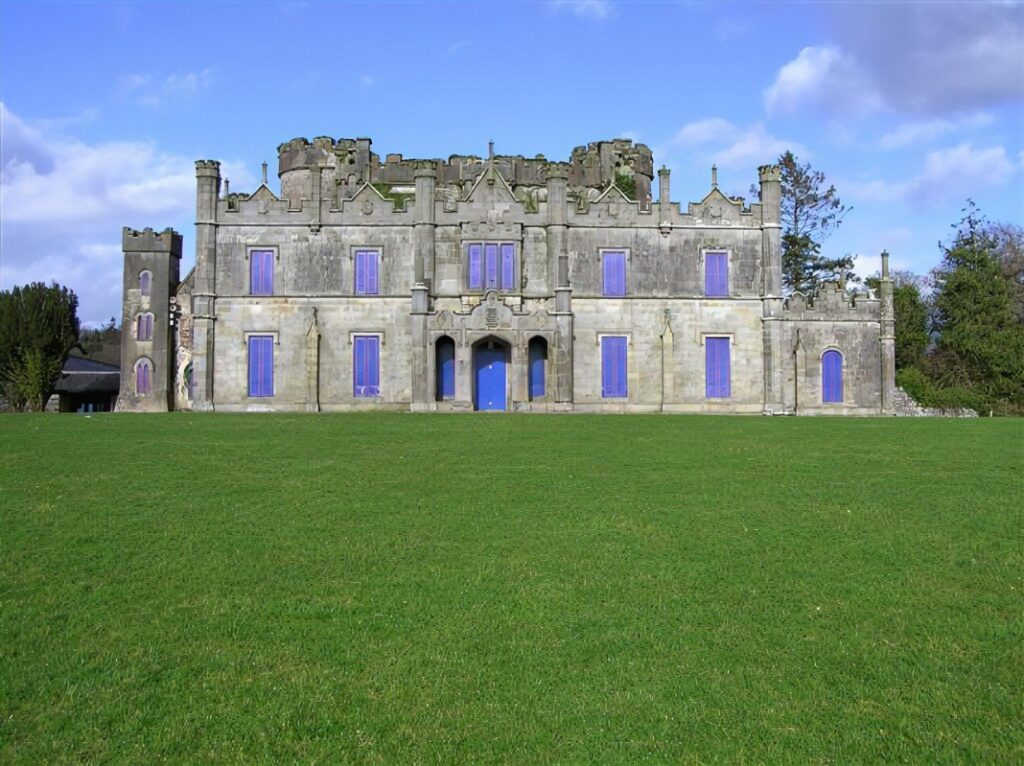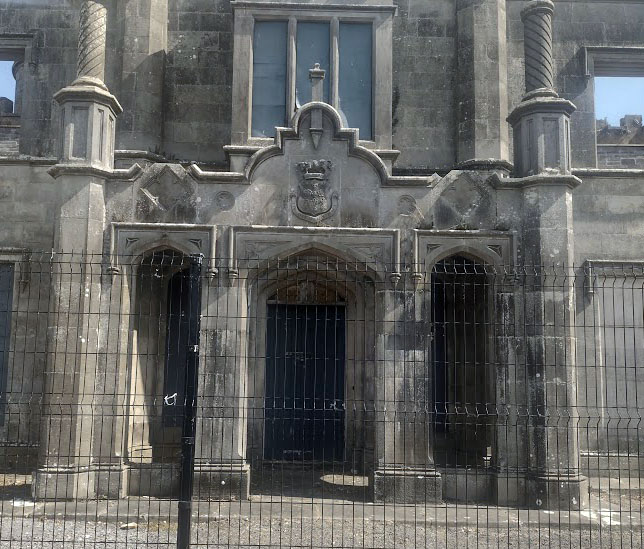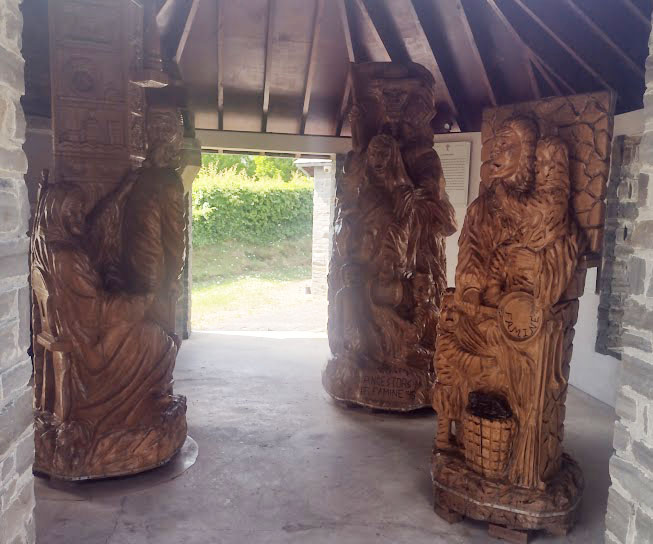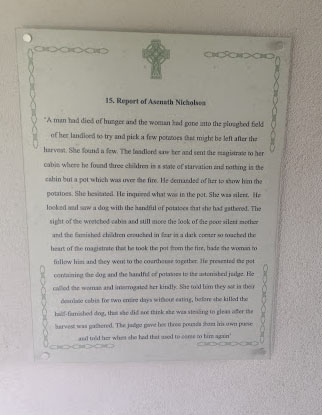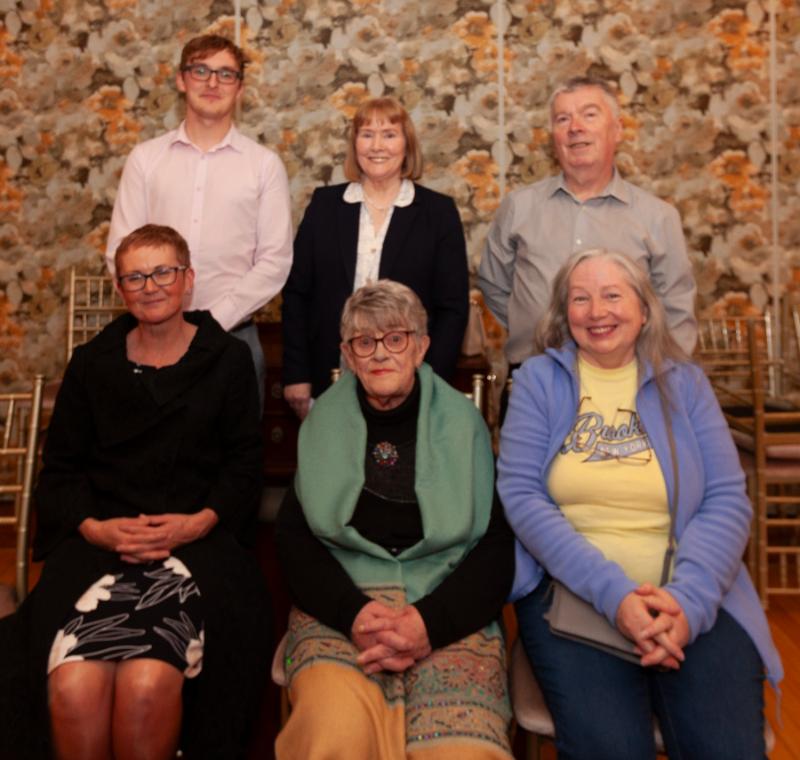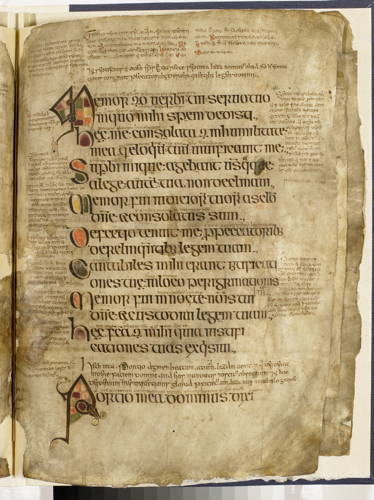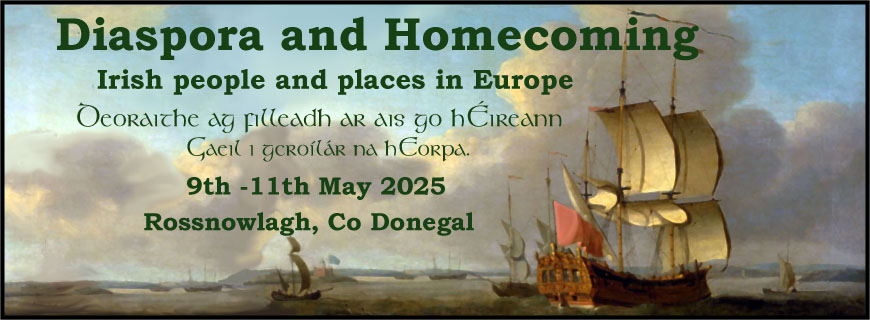
The 2025 Mícheál Ó Cléirigh Summer School was held over the weekend of Friday 9th to Sunday 11th May. The theme for the 2025 Summer School was “Diaspora and Homecoming” – Irish people and places in Europe. “Deoraithe ag filleadh ar ais go hÉireann” – Gaeil i gcroílár na hEorpa.
This was the eleventh annual Summer School and here is the programme of the weekend events. See below.
Mark the dates in your diary and we look forward to meeting you at the Summer School this May (9th-11th)
Friday 9th May – A brief rundown of the events
7.00 pm-Introduction by Martina Needham Chairperson of the Organising Committee Mícheál Ó Cléirigh Summer School
Martina Needham welcomed the attendees to the 2025 Summer School. This is the eleventh annual History summer school which began in 2014 with the coming together of three separate parts of the organisation 1. The Rossnowlagh Franciscan Friary give us the facility of the Mícheál Ó Cléirigh Hall ( Friary Hall) The Mícheál Ó Cléirigh Institute UCD who provide the speakers and the local organising committee who organise the history weekend
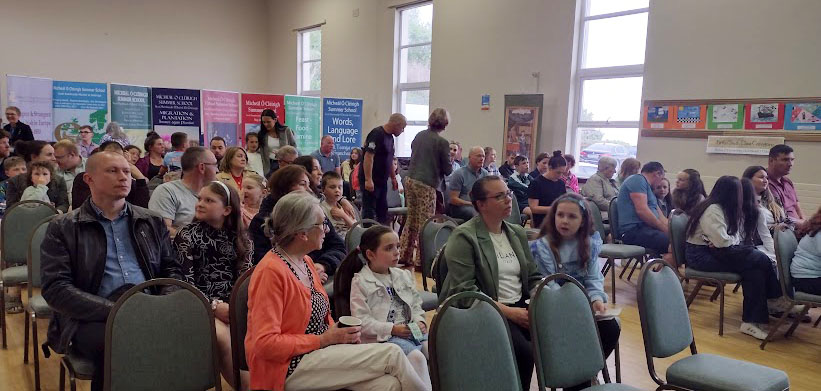
7.10pm -Official Opening of the 2025 Summer School
by Joe Mahon
Joe Mahon, opened the 2025 history Summer School. He is familiar to most people by his programmes on UTV; ‘ A Lesser Spotted Ulster ‘ ‘Ulster Giants’ and more recently ‘ Mahon’s Way’ In these programmes Joe examines the history and culture of a particular place, interviewing people who have an interest in their area, finding stories that bring history to life in a very relaxed way. It is particularly important for a summer school that looks at Irish history from the late Medieval period to invite a person to open our school, who through his work has brought people enjoyment in their own place and perhaps has encouraged others to discover more about their own history and culture.
Joe is, a native of Derry/ Londonderry, started his career as a schoolteacher, teaching English and History. He went on to work on BBC Radio Foyle as a contributor before becoming a producer. He then became manager of Radio Foyle, before moving to TV. He worked at the BBC and later joined UTV as a producer on their popular programme on local places called ‘McGilloway’s Way’ When Ollie McGilloway, the presenter of McGilloway’s Way, died unexpectedly in 1994, it was decided to relaunch the programme as ‘Lesser Spotted Ulster’ with Joe taking over as the presenter. In the years since Joe’s relaxed manner in the way he interviews people about their place and home district has led to a number of like programmes such as Lesser Spotted Journeys, Ulster Giants, and Mahon’s Way.
For those not all that familiar with Joe Mahon’s TV programmes such as Lesser Spotted Ireland see :
https://youtube.com/@lesserspottedireland?si=X5uiFKyj-P-XjJAZ
7.30pm Primary School Art Competition
This year the Organising Committee had over five hundred entries from eight Primary Schools in Counties Donegal, Leitrim and Fermanagh to take part in the competition. There were four age categories ; Junior/Senior Infants; Classes 1&2; Classes 3&4 and Classes 5&6.
All art entries were displayed in the Hall over the Summer School Weekend and prizes were awarded to First, Second and Third places with certificates highly commended to those deemed excellent by the judges.
8.00pm Coláiste Cholumcille School Choir
This was the first year that the Coláiste Cholumcille School Choir performed at the Summer School. The choir was conducted by Mark Cronin.
Coláiste Cholumcille, post primary school is situated in Ballyshannon, Co Donegal and is a place of learning for almost 700 pupils from the surrounding area. The school covers a huge geographical proximity with a catchment area which hosts seventeen feeder schools – which span from north Sligo, schools across south Donegal and Leitrim.
8.30pm Comhaltas Ceoltóirí Éireann- Phil Rooney Branch
Members of the Phil Rooney Comhaltas group closed the Friday evening event. The group are active all year round promoting traditional Irish music and encouraging young players. They celebrate the rich heritage of traditional Irish music, song, dance, and language across Ballyshannon, Bundoran, Kinlough, and Tullaghan.
9.30pm Comhrá le Caitlín Óstsan an Sandhouse
Bhuail an grúpa comhrá Éireannach le chéile in Óstán Sandhouse oíche Dé hAoine ina dhiaidh sin. Labhair an grúpa agus agus dúirt Maura Logue linn faoina léiriú atá le teacht i ndráma faoi bheirt bhan a chuir i bhfeidhm ar a saol féin a rialú.
Bhí go leor spraoi agus craic!
The Irish conversation group met in the Sandhouse Hotel on Friday night afterwards. The group chatted and and Maura Logue told us about her upcoming performance in a play about two women who set about controlling their own lives.
There was much fun and craic!
Saturday 10th May – A rundown of Events
10 55am- Introduction of the Speakers
Chairperson Martina Needham introduced the speakers to the assembled audience. The speakers were a mixture of academics who had carried out recent research in their field of interest. In addition two qualified local historians told us about their interest of study.
11am-Aims and Objectives of the 2025 History Summer School
by Dr. John Mc Cafferty
John set out the aims and objectives of the 2025 Summer School which looked at the movement of Irish from these shores in the period from 1500 to 18l00. This period saw a large outflux of Irish people to the Continent in exile whilst others were transported to the West Indies to face a life of toil The speakers examined these issues in more detail based on the most recent research carried out .
11-15am Drumholm Monastic Settlement
By Pierce Ferriter
Pierce is an historian and writer. He has a BEd from St.Patrick’s Training College, Dublin, a B.A. in Gaidhlig and Literature an M.Sc. in Gaidhlig from Sabhal Mór Ostaig, University of Islands and Highlands, Scotland. A former primary school teacher and principal, he has studied in Ireland, Scotland and Germany.He is an active member of his local community of Laghey and Drumholm have these communities have greatly benefited from Pierce Ferriter’s love of learning and all aspects of Irish culture, including Gaelic sports and music.
Drumholm was the site of an early Columban Monastic settlement which was sited close to the royal rath of the Cinél Connaill. The research and surveys carried out by Drumholm Heritage Society of which Pierce is a leading member has cast new light into the importance of this early monastic foundation.
12 noon Keynote Address – The Continental Colleges, origins, achievements & legacies
by Professor Emeritus Thomas O’Connor
Irish exiles founded many colleges in Europe, mainly to educate Catholic priests whose education was forbidden in Ireland up until Maynooth opened in 1797. Colleges such as Salamanca, Louvain, Douai Paris St Isafore’s in Rome and Prague.
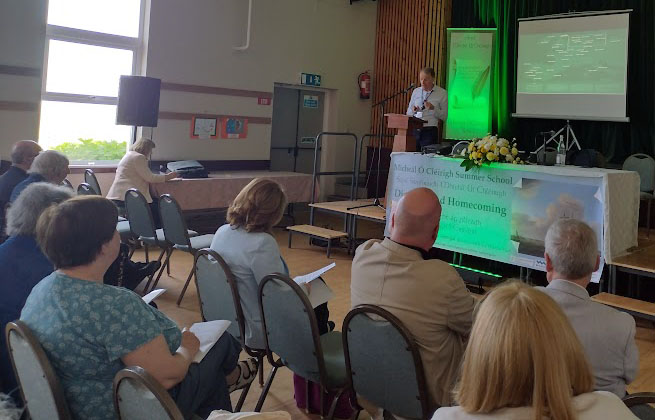
P
Professor Thomas O’Connor is Emeritus Professor at Maynooth University Arts and Humanities Institute. He holds a DEA and PhD from the Sorbonne. His undergraduate courses include the Spanish Inquisition, the French Wars of Religion and early modern migration. His research interests are in early modern European migration and religion, especially Jansenism, Inquisitions, censorship, ideological controls, social discipline and religious conversion. He is co-director of the Irish in Europe Project and editor of the history sources journal, Archivium Hibernicum. He is a member of the Irish Manuscripts Commission and of the Fondation Irlandaise (Paris). He has published several monographs in early modern European history. He has edited and co-edited four volumes in the Irish in Europe series, co-authored a guide to the Strangers to Citizens Exhibition in the National Library Ireland and contributed to numerous scholarly periodicals and essay collections. He has edited a collection of essays on abroad colleges in early modern Europe, which appeared with Manchester University Press in late 2017. He also co-edited, for Brill, an essay collection presenting new archival research on individual Catholic colleges in seventeenth- and eighteenth-century Europe. This volume appeared in early 2018.
2.00pm Irish service in the British Army at Home and in Europe
By Professor Charles Ivar McGrath
The aftermath of the wars of the 16th and 17th Centuries in Ireland left many officers and soldiers without employment. Many of those on the defeated Irish side opted to leave and join the armies of France and Spain. On the other hand, many of those who fought on the victorious English side were incorporated into the British Army.
One such regiment, the Inniskilling Foot and Dragoons originally recruited in 1688 from the townsmen of Enniskillen, Co Fermanagh . They took part in the subsequent battles in the Williamite War. at the Boyne and the Siege of Limerick. After the Treaty of Limerick in 1692, ‘the Inniskillings’ went on to fight as part of A contingent from the regiment took part in the Siege of Namur in August 1695 during the Nine Years War.
Professor Charles Ivar McGrath is Professor in the School of History, University College Dublin (UCD). He received his BA (1989) and MA (1992) from UCD and his PhD (1997) from the University of London. His publications include Lansdowne FC: A History (Dublin, 2022), Ireland and Empire, 1692-1770 (London, 2012), The Making of the Eighteenth-Century Irish Constitution: Government, Parliament and the Revenue,1692-1714 (Dublin, 2000), articles in The English Historical Review, Irish Historical Studies, Parliamentary History, Eighteenth-Century Ireland, The History of European Ideas, The Historical Journal and several edited collections and reference works, as well as co-edited works as follows: Converts and Conversion in Ireland, 1650-1850 (Dublin, 2005); Money, Power and Print: Interdisciplinary Studies on the Financial Revolution in the British Isles (Newark, 2008); and People, Politics and Power: Essays on Irish History 1660-1850 in Honour of James I. McGuire (Dublin, 2009). His most recent book, with Frances Nolan, is A list of the claims as they are entered with the trustees at Chichester House on College Green, 1700 (Irish Manuscripts Commission, 2024). Outside of academia, he spent three years serving as a private soldier in the Irish army including six months with UNIFIL in 1984-5, and eighteenth months in the civil service in London in 1992-3.
3.00pm Ritual Landscape of South Donegal
by Bridget Brennan
Graduated from IT Sligo with a First Class Honours Degree in Applied Archaeology in 2014. Recent graduated from ATU, Sligo. Bridget will talk about the rich pattern of ancient burial sites and the profusion of Rath settlements in the South Donegal geographic area.
3.30pm Tea/ Coffee Break
3.45pm Irish Merchant Communities in France, Spain and Spanish Flanders 1650-1750
By Professor (Marian)Mary Ann Lyons
Marian Lyons is Professor of History at Maynooth University. She has published extensively on Franco-Irish relations and on Irish migration to continental Europe in the early modern period. She has contributed to and co-edited several essay collections on Irish migration to Europe in the early modern period, jointly curated the ‘Strangers to Citizens: the Irish in Europe, 1600-1800’ exhibition at the National Library of Ireland and co-authored Strangers to citizens: the Irish in Europe, 1600- 1800 (2008). She has also published on various aspects of Irish history including the Kildare dynasty, religion and women in late medieval and early modern Ireland, and the emergence of professional medicine from the early 1600s onwards. citizens: the Irish in Europe, 1600-1800 (2008). Arising from her interest in local history, she is General Editor of the Maynooth Research Guides for Irish Local History series (Four Courts Press), and joint editor, together with Daithí Ó Corráin of The Irish Revolution 1912-23 series (Four Courts Press). She is currently working on a biography of Thomas Arthur, M.D., of Limerick (1593-1675).
Overview of the 2025 Summer School Book
By Brian MacAmhlaigh Eagarthóir/Editor
Brian will talk about the book that is produced after each Summer School. We currently have the 2016,2017, 2018,2019, 2021 2022 2023 & 2024 books available.
6.30pm Dinner in the Sandhouse Hotel, Rossnowlagh
8.00pm Bel Canto Choir- Conducted by Angela Currid

Sunday 11th May – A brief rundown of the Morning Events
9.00 am – Aifreann i nGaeilge agus i mBéarl
Mar chuimhne ar Br Mícheál Uí Cléirigh-Séipéal na mBráithre
A special mass was is held in the Friary Chapel to honour the memory of Br Mícheál Ó Cleirigh and the other annalists who were instrumental in the preservation and compilation of many ancient manuscripts culminating in the monumental work of the Annals of Ireland (Annals of the Four Masters)
10.00am Four Masters Tour of Local Historical sites
This year’s Four Masters Tour route took the assembled group out of County Donegal and into the neighbouring County Fermanagh. The group left Rossnowlagh passing through Ballyshannon and Belleek.
Keenaghan or Tievealough Abbey
The tour set out from Rossnowlagh paasing through Ballyshannon an Belleek heading north east passing Keenaghan or Tievealough Abbey. Legend tells that When the Vikings raided along the Erne river system in search of riches, they captured a cleric from Armagh named Maolcabha. Legend tells us that, on their departure the Vikings released him at Belleek where he went to Keenaghan Lake and founded a hermitage. The original hermitage was made of wood construction, so no trace remains.
Around 1178, Cistercians from Boyle founded the Abbey at Ballyshannon. The territory under their control extended from as far as Co. Tyrone near Irvinestown. They also held the salmon and eel fishing rights on the Erne. To service this property they inherited smaller churches at Teetunney, Keenaghan and Slawin on the south shore of the Erne. At certain times of the year Monks from Keenaghan would go to Slawin to assist there and the route they took was known as the ‘Deans Path’. The river could be forded at Druminillar in fine weather. These churches were older foundations probably dating back to the sixth century. Some historians (Cooke) indicate that the Abbey at Tievealough was a Franciscan foundation.
The graveyard has been used up to recent times and both Protestants and Catholics buried there.
Caldragh- Janus figure
The first stop was on Boa Island on Lower Lough Erne where the group visited Caldragh Cemetery where two ancient stone figures are sited. The better known is the Janus Figure, one that faces two ways and a smaller figure taken from Lustymore Island close by Boa Island. Boa Island gets its name from Badhbha who was a Godess of the Uladh tribes.
The Janus (two headed) figure is the Boa largest of the Boa sculptures, and is regarded as one of Ireland’s most enigmatic and remarkable stone figures. It is thought to represent a Celtic deity and could represent a Celtic goddess as readily as a god, especially given the name of the island. In Celtic mythology, heads were given great importance as they were thought to contain a person’s spirit, and severed heads were sometimes taken in triumph after battles. Over the centuries, Boa Island and Caldragh Cemetery have seen various inhabitants. The island’s strategic location in Lough Erne made it a significant site throughout history.The Janus figure, in particular, has sparked much interest due to its unique two-faced design, which is rare in early Christian iconography. The cemetery itself has remained relatively undisturbed over the years, preserving its historical integrity. This has allowed for a more authentic understanding of the site’s original purpose and significance.
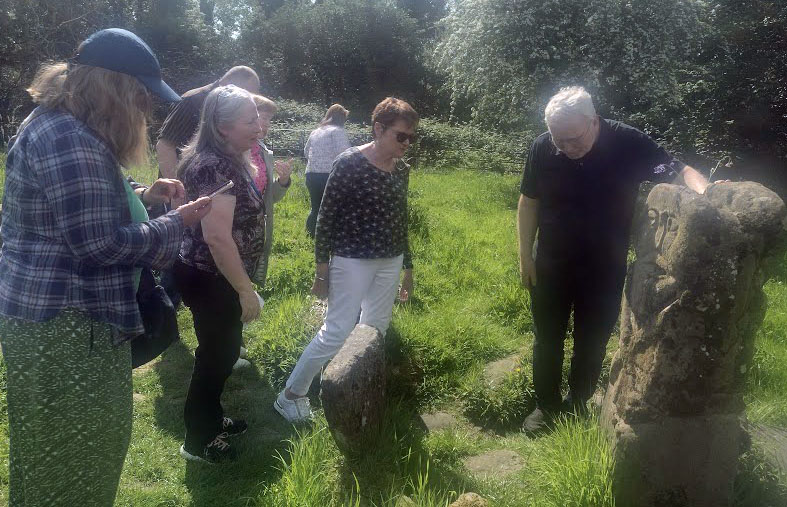
Necarne Castle
The group travelled onwards to Irvinestown passing through the village of Kesh. Just some distance from the centre of the town is the ruins of Necarne Castle. Necarne Castle, also known as Castle Irvine, is a Victorian gothic styled house, now in ruins though the facade is still very impressive.
A tower house and bawn were built by a man named Gerald Lowther after the Plantation of Ulster completed circa 1619. The family also built the nearby village naming it Lowtherstown. The lands passed to the Irvine family later in the 17th century and they renamed the town Irvinestown,The two-storey façade of the castle was designed by John Benjamin Keane and was completed in 1835, with a new Tudor-Gothic south wing.
John B. Keane (1800=1859)is first heard of as an assistant to RICHARD MORRISON , for whom he was working by 1819 or 1820, [1] During the next two decades he received several important commissions including the new Queen’s College, Galway, Tullaghmore Courthouse and a number of major Catholic churches in Dublin (Saint Francis Xavier Church)and elsewhere.
The Irvine family remained in residence until 1922 when Major D’Arcy Irvine moved to England. The house and demense was bought by Captain Richard Outram Hermon from Sussex in 1925. He was delighted with its setting and grounds and along with his wife Coralie (Cozie) they set about restoring the house to its former glory and no money was spared.
During WWII (1939-1945) the castle was used as a military hospital. After 1941 it was used by the American army who were based at nearby Castle Archdale.
Captain Hermon died in 1976 and the castle and estate was bought by Raymond McCartney of Enniskillen. He later sold it to Fermanagh District Council.
In the 1990s the Department of Agriculture, Environment and Rural Affairs signed a 25 year lease on the property to use it as an equine training centre which ran until 2023.
Garden of Saints
We were not sure in the weeks previous if we would be able to visit the Garden of Saints as there had been severe storm damage to the site. However part of the site was open and we were able to see these wonderful sculptures carved by Jonas Raiskas. He was the artist who carved all the sculptures in the garden. He is a native of Lithuania and came to Irvinestown to work in 2007. Devenish Parish commissioned him to carve, from native Irish oak, the sculptures of Celtic Saints. He worked from 2007-2011 carving all the beautiful figures in the garden.It is filled with memories of the Saints of the Golden Age of the Irish Church. The names of Patrick, Brigid, Columcille, Columbanus, Gall, Kilian and Molaise will bring to mind the riches and glories that existed in the Irish Church from the time of Saint Patrick.
We were able to see the part dedicated to the memories of the Irish Famime ‘An Gorta Mór’ which lasted from 1845 to 1849.
Mahon’s Hotel
The group had tea coffee and sandwiches in Mahon’s Hotel.
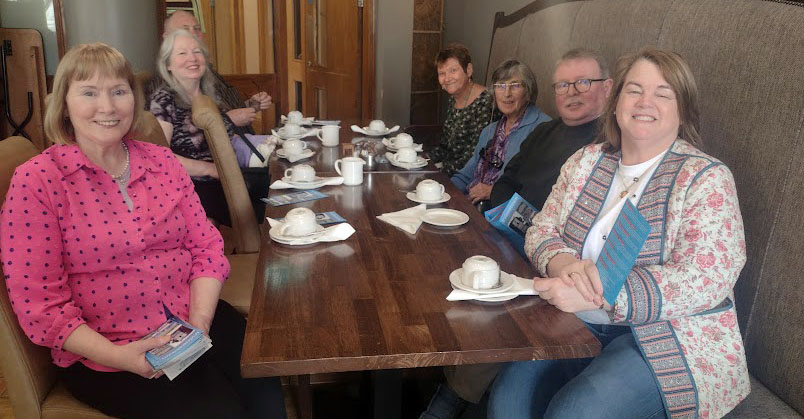
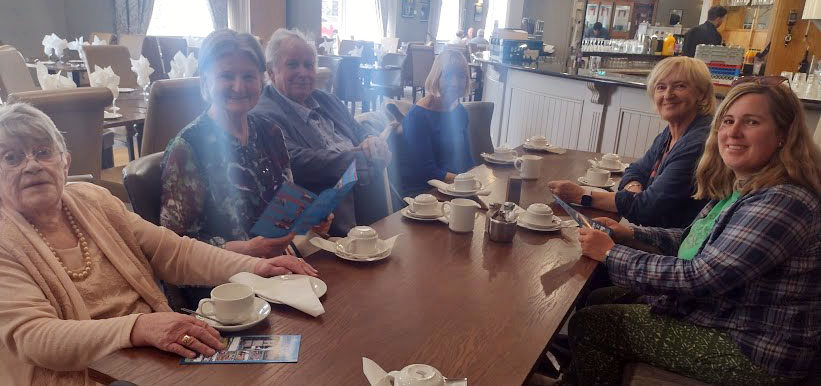
Welcome to the Mícheál Ó Cléirigh Summer School
Fáilte chuig Scoil Samhraidh Mhíchíl Uí Chléirigh
A Summer School for remembering, for learning, for enjoyment. We remember a great local man, Mícheál Ó Cléirigh. We learn from scholars about his story and his times. We begin to understand what this means for us today. And we enjoy ourselves.
We travel to local historic sites. We visit Mícheál’s birthplace. We walk the beautiful Rossnowlagh beach. We talk late into the evening in the local hostelries. Welcome to the Mícheál Ó Cléirigh Summer School to a family distinguished by scholarship. His older brother, Maolmhuire (Fr Bernadine) was ordained in Salamanca, Spain, later moving to Louvain, Belgium in 1619 and Michael joined him a few years later. As a lay brother Michael was able to concentrate on historical research and transcription rather than on priestly duties.
In 1626 he was dispatched by a fellow Donegal man, Hugh Ward to Ireland to collect the lives of the Irish saints. This he did. But he also did more. For 10 years, Michael travelled the length and breadth of Ireland gathering the ancient manuscripts and histories wherever he could find them. He and his collaborators transcribed the material into Annála Ríochta na hÉireann (the Annals of the Four Masters). They left us with an incomparable record of the history of Ireland.
The Mícheál Ó Cléirigh School has been set up by a partnership of:
Local Organising Committee
Local people from Ballyshannon, Creevy and Rossnowlagh area in Co. Donegal who wish to preserve the memory of Mícheál Ó Cléirigh, a local hero who did so much to preserve the ancient and medieval period of Irish History. The committee begin work in September each year planning the upcoming Summer School
Franciscan Community Rossnowlagh
The Franciscan Friars who established a Friary on Donegal Bay 1474 and played such an important part in Irish writing and scholarship from their monasteries in Ireland and Louvain.
Mícheál Ó Cléirigh Institute UCD
The Mícheál Ó Cléirigh Institute at University College Dublin repository of an unparalleled archive of historical documents and the centre of voluminous research on Irish medieval history since its inception in the year 2000. See: www.ucd.ie/mocleirigh
The Mícheál Ó Cléirigh Summer School Rossnowlagh, Co. Donegal
Background
2014–
The inaugural programme of the Mícheál Ó Cléirigh School took place on Saturday 17th May, 2014. with the theme “Mícheál Ó Cléirigh” The main events were held in the Ó’Cléirigh Hall beside the Franciscan Friary at Rossnowlagh, close by the birthplace of Mícheál Ó Cléirigh on lands that belonged to the Ó Cléirigh clan, prior to 1610. The venue was an appropriate one, as it was built by the Franciscan Friars who returned to Donegal in 1946. They were, of course, influenced by the association of the area with some of the renowned members of their Irish fraternity, such as Mícheál Ó Cléirigh, John Colgan and Hugh Ward. See: Summer School 2014 – Theme Mícheál Ó Cléirigh
2015 –
The Second Mícheál Ó Cléirigh School took place at Rossnowlagh on the weekend of 15th – 17th May, 2015. The theme was “Saints and Scholars” “Naomh agus Scoláirí ” The original purpose of Mícheál Uí Cléirigh’s return to Ireland was to collect information on the many Irish Saints and to record their information. For Further information see: 2015 Theme Saints and Scholars
2016-
The Third Mícheál Ó Cléirigh Summer School was held over the weekend of Friday 27th May to Sunday 29th May 2016. The theme was “Refugees and Strangers” “Dídeanaithe agus Strainséirí ” This examined the exodus of many of the Gaelic nobility who left Ireland for European countries and how they coped by being refugees far from their native land. For Further information see: 2016- Refugees and Strangers: being Irish in Europe 1500-1800
2017-
The Fourth Mícheál Ó Cléirigh Summer School was held over the weekend of Friday 12th May to Sunday 14th May 2017. The theme was “Irish and European” “Gaelach agus Eorpach” The weekend events looked at the relationship between Ireland and European countries in the 16th and 17th Centuries and how this has continued to the present time. For Further information see: 2017- Irish and European
2018-
The Fifth Mícheál Ó Cléirigh Summer School was held over the weekend of Friday 11th May to Sunday 13th May 2018. The theme was “Annals and Earls” “Annála agus Iarlaí ” This looked at the way the Ulster Earls were described in the Annals of the Four Masters and did they have a particular O’Donnell favouritism in their recording of the events of the late 16th and Early 17th Centuries. For Further information see: 2018 Annals & Earls
2019-
The Sixth Mícheál Ó Cléirigh Summer School was held over the weekend of Friday 10th May to Sunday 12th May 2019. The theme was “Migration and Plantation” “Imirce agus Plandáil” The Ulster Plantation had a tremendous effect on the lives of the Gaelic Scholars and they found that their skills and learning was no longer required. For Further information see: 2019 Migration & Plantation
2020-
Due to Covid 19 health restrictions the 2020 Summer School was cancelled.
2021 –
A Virtual Summer School was held from Thursday 6th to Sunday 9th of May. The theme was “Women in Turbulent Times- Mná in Aimshir Chorraithe 1551- 1651” This virtual school looked at the way women of the period recorded events in letters sent to their parents husbands and siblings and how they wrote about the things that mattered to their lives and families. For Further information see: 2021 Women in Turbulent Times
2022-
The 2022 Summer School was held School was held over the weekend of May 7th to 9th, The event was held in the Sandhouse Hotel in Rossnowlagh and the theme was Bloodshed and Retribution Doirteadh Fola agus Díoltas in the period 1530 to 1700. It looked at the changes from the Gaelic system of Brehon Law to the new system of English Common Law and how it differed from that of other parts of England Wales and Scotland. For Further information see: 2022 Bloodshed & Retribution
2023-
The 2023 Summer School was held over the weekend of the 5th -7th May and its theme was Feast – Food- Famine / Féasta- Bia-Ganntanas The various talks explored the hardships of day-to-day life in post medieval Ireland in the period from 1500 to 1800 where seasons good or bad could determine the life expectancy of men, women and children. It examined the importance that food or the lack of it can shape historical events of any period in history. For Further information see: 2023 Feast- Food- Famine
2024
The 2024 Summer School was held over the weekend of Friday 10th May until Sunday 12th May The theme for the weekend was Words, Language and Lore / Focail, Teanga agus Seanchas and it examined how words and language collided in the Ireland of Mícheál Ó Cléirigh. For Further information see:

